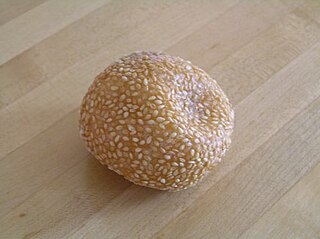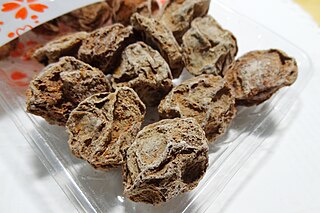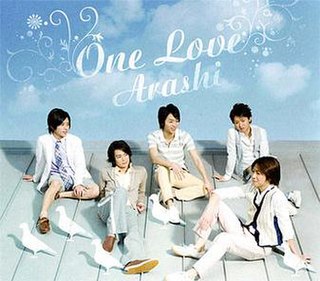
Chi chi dango is a soft, sweet type of Dango, a Mochiko (sweet rice flour) dessert confection of Japanese origin. It is popular in Hawaii, particularly during Girl's Day celebrations. [1]

Chi chi dango is a soft, sweet type of Dango, a Mochiko (sweet rice flour) dessert confection of Japanese origin. It is popular in Hawaii, particularly during Girl's Day celebrations. [1]

Dango is a Japanese dumpling made from rice flour mixed with uruchi rice flour and glutinous rice flour. It is different from the method of making mochi, which is made after steaming glutinous rice. Dango is usually finished round shaped, three to five dango are often served on a skewer. Generally, dango comes under the category of wagashi, and is often served with green tea. It is eaten year-round, but the different varieties are traditionally eaten in given seasons.

Mochi is a Japanese rice cake made of mochigome (もち米), a short-grain japonica glutinous rice, and sometimes other ingredients such as water, sugar, and cornstarch. The steamed rice is pounded into paste and molded into the desired shape. In Japan, it is traditionally made in a ceremony called mochitsuki. While eaten year-round, mochi is a traditional food for the Japanese New Year, and is commonly sold and eaten during that time.

Wagashi is a traditional Japanese confection that is often served with green tea, especially the type made of mochi, anko, and fruit. Wagashi is typically made from plant-based ingredients with an emphasis on seasonality, and generally making use of cooking methods that pre-date Western influence in Japan.

The cuisine of Hawaii incorporates five distinct styles of food, reflecting the diverse food history of settlement and immigration in the Hawaiian Islands.[a]

Tsukimi or Otsukimi (お月見), meaning, "moon-viewing", are Japanese festivals honoring the autumn moon, a variant of the Mid-Autumn Festival. The celebration of the full moon typically takes place on the 15th day of the eighth month of the traditional Japanese calendar, known as Jūgoya; the waxing moon is celebrated on the 13th day of the ninth month, known as Jūsan'ya. These days normally fall in September and October of the modern solar calendar.

Bontan Rice Candy is a specific brand of a category of Japanese candy called bontan ame (ボンタンアメ). Bontan ame are soft, chewy, citrus-flavored candy with an outer layer of rice paper or Oblaat. The rice paper is clear and plastic-like when dry, but it is edible and dissolves in the mouth. This candy was invented by Seika Foods in 1924. During this period, more and more Western-style sweets were becoming popular in Japanese society, and the appearance of this type of candy is intentionally similar to Western-style caramel candies. In Japan, these candies are sold as Dagashi, cheap candies and snacks marketed to Japanese schoolchildren, and are often in small sizes with bright colorful packaging with stickers or prizes included.

Jiandui or sesame balls are a type of fried Chinese pastry made from glutinous rice flour. The pastry is coated with sesame seeds on the outside and is crisp and chewy after immediately being cooked. Inside the pastry is a large hollow, caused by the expansion of the dough. The hollow of the pastry is filled with a filling usually consisting of lotus paste, or alternatively, sweet black bean paste, or red bean paste.

Li hing mui, known as huamei in Mainland China, is salty dried Chinese plum. It has a strong, distinctive flavor and is often said to be an acquired taste, as it has a combination of sweet, sour, and salty taste. Originally from Guangdong Province, the name "li hing mui" means "traveling plum". "Li hing" is "traveling" and "mui" is "plum" in Cantonese. Li hung mui is called hoshiume in Japan, where the salty and sour umeboshi is also popular. Li hing mui, along with li hing powder, is extremely popular as a snack in Hawaii.

"One Love" is the twenty-second single of the Japanese boy band, Arashi. The single was released in two editions: a regular edition containing the karaoke versions of all the songs released in the single, and a limited edition containing only the title track and a DVD of the music video. For the first time in Arashi's discography, a song remix of all the three Hana Yori Dango theme songs was included in the Limited Edition release. The single was later re-issued in commemoration of the success of Hana Yori Dango Final with an insert of two-minute dialogue by Arashi member Jun Matsumoto acting as his Hana Yori Dango character Tsukasa Dōmyōji.

Mitarashi dango (みたらし団子、御手洗団子) are traditional Japanese rice flour dumplings (dango) that are skewered onto sticks in groups of 3–5 and are covered with a sweet soy sauce glaze. They are characterized by their glassy glaze and burnt fragrance.
Kibi dango may refer to:

Okowa おこわ (強飯) is a Japanese steamed rice dish made with glutinous rice mixed with meat or vegetables. It is sometimes combined with wild herbs and vessel chestnuts. It is generally boiled glutinous rice blended with azuki beans to give it red color for festive look, made by boiling regular rice with azuki beans. Since okowa is meant to be eaten at room temperature, it is used to make onigiri for its capacity to be frozen well.

Butter mochi is a cake made from coconut milk, glutinous rice flour, and butter and is a popular dessert in Hawaiian cuisine.